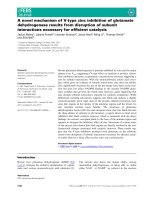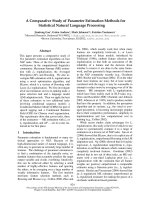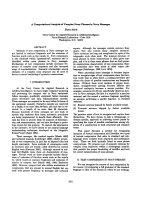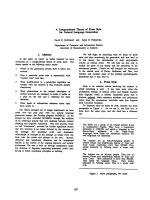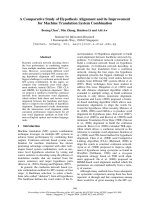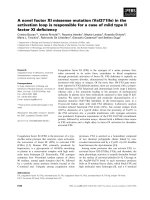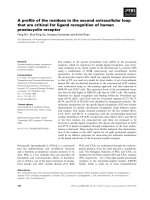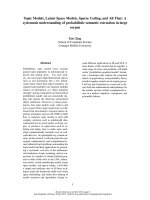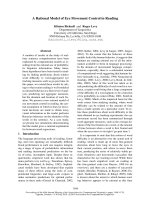báo cáo khoa học: " A protocol for a systematic review of knowledge translation strategies in the allied health professions" doc
Bạn đang xem bản rút gọn của tài liệu. Xem và tải ngay bản đầy đủ của tài liệu tại đây (238.61 KB, 7 trang )
STUDY PROT O C O L Open Access
A protocol for a systematic review of
knowledge translation strategies in the allied
health professions
Shannon D Scott
1*
, Lauren Albrecht
1
, Kathy O’Leary
1
, Geoff DC Ball
2,3,4
, Donna M Dryden
2,5
, Lisa Hartling
5,6
,
Anne Hofmeyer
7
, C Allyson Jones
8
, Kathy Kovac Burns
9,10
, Amanda S Newton
2,11,12
, David Thompson
13
and
Terry P Klassen
14,15
Abstract
Background: Knowledge translation (KT) aims to close the gap between knowledge and practice in order to
realize the benefits of research through (a) improved health outcomes, (b) more effect ive health services and
products, and (c) strengthened healthcare systems. While there is some understanding of strategies to put research
findings into practice within nursing and medicine, we have limited knowledge of KT strategies in allied health
professions. Given the interprofessional nature of healthcare, a lack of guidance for supporting KT strategies in the
allied health professions is concerning. Our objective in this study is to systematically review published research on
KT strategies in five allied health disciplines.
Methods: A medical research librarian will develop and implement search strategies designed to identify evidence
that is relevant to each question of the revie w. Two reviewers will perform study selection and qu ality assessment
using standard forms. For study selection, data will be extracted by two reviewers. For quality assessment, data will
be extracted by one reviewer and verified by a second. Disagreements will be resolved through discussion or third
party adjudication. Within each profession, data will be grouped and analyzed by research design and KT strategies
using the Effective Practice and Organisation of Care Review Group classification scheme. An overall synthesis
across professions will be conducted.
Significance: A uniprofessional approach to KT does not represent the interprofessional context it targets. Our
findings will provide the first systematic overview of KT strategies used in allied health professionals’ clinical
practice, as well as a foundation to inform future KT interventions in allied healthcare settings .
Background
On national and international stages, strategies to close
the gap between what we “know” (research) and what we
“do” (practice) have been consistently identified as a prior-
ity [1,2]. Knowledge translation (KT) aims to close the gap
between knowledge and practice in order to realize the
benefits of research in the areas of improved health out-
comes, more effective health services and products, and
strengthe ned healthcare systems [3]. It is well established
that healthcare decisions based on sound evidence are cru-
cial for ensuring high-quality patient care, optimal health
outcomes, and quality and safety in healthcare systems.
Thus, there is a need to identify and implement strategies
that facilitate evidence-based decision making and ensure
uptake of evidence into practice [4].
Over the past decade there has been rapid expansion
of available scientific evidence to inform healthcare
practices, with endorsement of evidence-informed
healthcare by professional governing bodies and health-
care professional training programs. Concomitantly,
improvements to the healthcare system have consis-
tently been moving away from episodic unidisciplinary
healthcare to interprofessional, collaborative models of
practice with a patient-centered view of care.
Despite the interest in KT, there is a widening gap
between research and practice, with the majority of
* Correspondence:
1
Faculty of Nursing, University of Alberta, Edmonton, Alberta, Canada
Full list of author information is available at the end of the article
Scott et al. Implementation Science 2011, 6:58
/>Implementation
Science
© 2011 Scott et al; license e BioMed Central Ltd. This is an Open Access article distributed under the terms of the Creative Commons
Attribution License ( g/licenses/by/2.0), which permits unrestricted use, distribution, and reproduction in
any medium, provided the original work is properly cited.
healthcare professionals not drawing upon the best
research evidence to guide clinical practice decisions
[5,6]. In order to address this gap, various KT strategies
have been developed and implemented, such as interac-
tive educational sessions and audit and feedback of
healthcare practices. Previous systematic reviews have
evaluated the effectiveness of some of these KT strate-
gies in the context of specific professional groups, such
as physicians and nurses [7-10], yet existing reviews
have two notable limitations. First, current reviews do
not reflect the interprofessional and interdisciplinary fla-
vor of Canada’s healthcar e landscape. Ther e is a lack of
systematic reviews specific for KT strategies for health
professions allied to medicine and nursing. Health pro-
fessional groups differ widely in training, education,
organizational structure, and scope of practice and
knowledge, thus, KT strategies that are successful in one
profession may not seamlessly transfer to another pro-
fession. Effective healthcare delivery is dependent on a
coordinated effort amongst health professionals from
different disciplines [4,11,12], thus, a better understand-
ing of effective KT strategies specific to health profes-
sions allied to medi cine and nursing is urgently needed.
Second, existing reviews privilege studies employing trial
designs or studies with controls. This project will
address these limitatio ns through a series of interrelated
systematic reviews (one per profession), synthesizing evi-
dence from research using diverse study designs evaluat-
ing KT strategies in the allied health professions.
An allied health professional is an individual who pro-
vides specific types of acute care, management for
chronic conditions, prevention, or health promotion and
who is educated and licensed with credentials to provide
that care but is not a physician, nurse, or dentist [13].
Each year, new disciplines are identified under the allied
health umbrella; therefore, defining it is challenging
[14]. For the purposes of this project, we have concep-
tualized allied health professionals to encompass and
reflect the key health professions (allied to medicine and
nursing) in the Canadian acute care health context, that
is, rehabilitation medicine (physiotherapy, occupational
therapy, speech-language pathology), dietetics, and phar-
macy. These professions, as well as nursing and medi-
cine, reflect the composition of many interprofessional
teams providing healthcare in many Canadian acute
care settings.
Understanding the most effective ways of translating
evidence into clinical practice for differ ent health profes-
sional groups and different healthcare settings was recog-
nized as a national key synthesis priority in Listening for
Direction II [1]. This priority (captured in Managing and
Adapting to Change) highlights the need to break down
organizational and professional silos that c haracterize
healthcare and understand the most effective ways of
translating evidence into practice from the perspective of
health professional groups. The findings from this
research project will provide critical information for
three stakeholder groups: (1) allied health professionals,
(2) decision makers who are charged with increa sing the
use of the latest research in healthcare settings, and (3)
researchers conducting KT intervention studies.
One of the contributions of this project will be the
developm ent of products outlining the synthesis of find-
ings in al lied health profession-specific reviews. By
synthesizing the evidence across the disciplines, in other
words, reflecting an interprofessional flavor, we will
begin to u nderstand how the natur e (e.g., extent of
autonomy, scope of practice) and s tructure of the work
within each healthca re discipline shapes the success of
specific KT strategies. The involvement of allied health-
care decision makers from the clinical practice, research,
and education sectors from inception of the project will
ensure that the findings from this project result in the
development of salient interprofessional evidence-based
strategies to improve KT across multiple allied health
professions, thereby reflecting the current healthcare
landscape.
Methods/design
Aim and objectives
KT interventions or strategies are overt activities or
devices that facilitate or encourage use of the research
to make a clinical practice change. The literature has a
great number of different strategies that can be used
when introducing innovations and changes, such a s
reminders, financ ial incentives, organizationa l measures,
audit, and feedback. This project will synt hesize the evi-
den ce on KT interventions used in the allied healthcare
professions. In order to do this, we will conduct a seri es
of reviews for each profession using the same methods
for each review. Following the completion of the five
systematic reviews, we will synthesize the evidence
across the reviews to look for similarities and patterns
in terms of key factors, such as KT strategies employed,
project design, and outcome measures.
The objectives for the large project are to
1. systematically locate, assess, and report on studies
from each respective allied health profession [1] that
have investigated the effects of KT interventions;
2. evaluate the interventions used to translate
research into practice in terms of changes at the
healthcare system, health provider, and/or patient
level;
3. describe how the interventions worked and the
modifying variables relevant to the respective context
(that is, for whom does the intervention work, under
what circumstances, and in what manner) [15];
Scott et al. Implementation Science 2011, 6:58
/>Page 2 of 7
4. provide possible strategies to facilitate KT for
allied healthcare professionals and decision makers
responsible for policy and institution/unit protocols
in healthcare settings;
5. offer guidance for KT researchers in terms of the
development of KT interventions for interprofes-
sional healthcare teams.
Key questions
In accordance with the larger project’s aim and objec-
tives, the following questions will guide this project:
1. What is the state of the science for KT strategies
used in the allied healthcare professions?
2. What methodological approaches have been uti-
lized in studies exploring KT strategies in the allied
healthcare professions?
Methods
The s ystematic reviews will follow a comprehensive pro-
cess using rigorous methodo logical guidelines to synthe-
size diverse forms of research evidence [16]. While the
methods outlined below are largely shaped by the conven-
tional approach to systematic reviews, we will supplement
these methods to accommodate the nature of the litera-
ture (e.g., complex interventions) and the different study
designs (e.g., randomized controlled trials [RCTs], qualita-
tive studies). We acknowledge that there is controversy
about the legitimacy and feasibility of combining the find-
ings of research studies employing different research
methods [17] (e.g., qualitative and quantitative); however,
the exclusive reliance on studies employing RCTs, con-
trolled clinical trials, controlled before and after studies, or
interrupted time series designs has created growing
unease, particula rly in t he policy sector, abo ut the utility
of these types of systematic reviews [16]. In short,
Cochrane-style reviews alone are not suffici ent to reflect
the complexities and intricacies of what decision makers
consider relevant “ evidence” to guide decision making.
Thus, in order to be responsive to the needs of decision
makers, the complexities of the clinical practice landscape,
and the diversity in the KT literature, the methodological
assumption guiding this project is one of inclusivity.
Literature search
A research librarian, in collaboration with the research
team, will develop and implement search strategies (Addi-
tional File 1) designed to identify evidence that is relevant
to each question of the review. Our search for studies to
be included in this review will be informed by previous
systematic review work by members of t his group (e. g.,
SDS and DT). Based on this work [10], we will work with
a research librarian to refine and test our search strategy
parameters for a project of this magnitude, involving a
comprehensive set of subject headings and keywords that
will be used in a variety of databases. Using language (Eng-
lish) and date (1985-2009) restrictions, we will systemati-
cally search the foll owing electronic databases that store
resources with this focus: PubMED, Scopus, Ovid MED-
LINE, Cochrane Central Register of Controlled Trials,
Cochrane Database of Systematic Reviews, Database of
Abstracts of Reviews of Effects, Health Technology Assess-
ment Database, HealthStar, EMBASE (Excerpta Medica),
CINAHL (Cumulative Index to Nursing and Allied Health
Literature), PsycINFO (Psychological Abstracts), ERIC,
and So ciological Abstracts. We will al so identify relevant
dissertations and search the reference lists of included stu-
dies for relevant citations and will hand-search key jour-
nals and conference proceedings for the past five years
from each of the allied health professions included in the
project. Utilizing parameters from previous work [10]
adapted for professional group nuances, we preliminarily
searched three key databases (casting a wide net) to assess
the scope of the literature to be screened for inclusion.
Study inclusion criteria
Studies will not be excluded based upon research design.
While controversial, the inclusion of stud y designs other
than exclusively RCT and quasi-experime ntal is particu-
larly important in an emerging field such as KT in the
allied health professions. The merit in including these
designs is that the results will reflect the rich and emer-
ging literature base in KT strategies as well as generate
hypotheses that could be tested in studies with more
rigorousdesigns.Studyselectionwillbeguidedbythe
inclusion criteria (Table 1).
Study selection
A two-step process will be used for study screening.
First, two project reviewers will independently screen
Table 1 Inclusion criteria
Study design Research studies including experimental, quasi-
experimental, and nonexperimental designs (e.g., case
study)
Participants Occupational therapists, physical therapists, pharmacists,
dietitians, speech-language pathologists
Interventions Interventions/strategies with a primary purpose of
translating research (or enhancing research uptake) into
clinical practice; examples of potential interventions
include reminders, use of multidisciplinary teams,
educational programs, researcher-clinician interventions
Outcomes Empirically assessed change (by way of quantitative or
qualitative data) at the professional (e.g., change in
clinical practice intervention), patient (e.g., improved
response to the clinical practice intervention), or
economic (e.g., change in staff-patient ratio) level
Scott et al. Implementation Science 2011, 6:58
/>Page 3 of 7
the titles and abstracts ( when available) to determine
whether a study meets the general inclusion criteria.
Each article will be rated as Include, Exclude, or
Unclear. The full text of all articles classified as Include
or Unclear will be retrieved for formal review. Next, two
reviewers will independently assess each study using a
standard form that outlines the predetermined inclusion
criteria. Disagreements will be resolved by discussion
between the two reviewers or third party adjudication.
Quality criteria
The process for assessing the methodological quality of
included studies will be guided by study design. Two
reviewers will independently assess the quality of
included studies. Discrepancies in quality assessment
will be resolved through discussion or third party adju-
dication. Interrater agreement will be calculated using
the weighted kappa statistic[18].Themethodological
quality of included quantitative s tudies will be assessed
using the Quality Assessment Tool for Quantitative Stu-
dies (Additional File 2) [19]. T he results from the tool
will lead to an overall methodological rating of strong,
moderate, or weak in eight sections: selection bias, study
design, confounders, blindin g, data collection methods,
withdrawals/dropouts, intervention integrity, and analy-
sis. This tool has been evaluated for content and con-
struct validity and interrater reliability and meets
accepted standards [19]. The methodological quality of
qualitative studies will be assessed using the Quality in
Qualitative Evaluation Framework (Additional File 3)
[20]. This established framework assesses 18 aspects,
including (1) credibility of the findings, (2) defensibility
of the research design, (3) sample composition, (4) data
sources, and (5) linkages between data, interpretation,
and conclusions.
Data extraction
Study data will be extracted using standard forms (Addi-
tional File 4) and entered into Microsoft Excel (Micro-
soft Corporation, Redmond, WA, USA) spreadsheets in
tabular form. Data will be extracted by one reviewer and
checked for accuracy and completeness by a se cond
reviewer. Data to be extracted include study design and
process, participant characteristics, KT intervention/
strategy details, and study findings. The data extraction
form will be tried on 10 studies to refine the form and
ensure the form captures all of the intricacies of both
qualitative and quantitative designs.
Data analysis and synthesis
First, analysis will occur on a profession-by- profession
basis, and a scholarly paper will document the findings
for each profession. Study data for each profession will
be grouped and analyzed by study design (e.g., qualitative,
RCT, controlled before and after studies ). Next, data will
be aggregated and analyzed acc ording to the type of KT
intervention strategy or strategies within each allied
health professional discipline. From this analysis we will
present a descriptive analysis of the included studies and
look at t he patterns in terms of the success of the KT
interventions.
A qualitative review of the studies across KT interven-
tions will allow us to not only examine what strategies
are successful but evaluate what it is about the different
strategies that may work, for whom, and under what cir-
cumstances [15]. The value of our review is that data
will not be pooled just to get an overall assessment of
whether something could work but rather assess
whether it does work given different scenarios. The
results of our review will richly add to the evidence base
as it goes beyond the results of a “ typic al” sy stematic
review through the inclusion of all study designs.
Following the analysis of the evidence within each
profession, the evidence across the professions will be
synthesized to reflect the interprofessional nature of
Canada’s healthcare landscape. Descriptive analyses will
be conducted to look for patterns in terms of successful
KT interventions. Evidence tables will be created that
describe all of the studies included in this project. Vari-
ables to be evaluated in the descriptive analysis include
country of primary author, study design, quality assess-
ment of studies, and KT intervention outcomes.
if there is sufficient clinical and statistical homogeneity
across groups of studies employing RCT designs, we will
perform meta-analyses using Review Manager (The
Cochrane Collaboration, Copenhagen, Denmark) [21].
We will first calculate the overall intervention effects
using DerSimonian and Laird’ s random effects model
[22,23]. This model assumes there is a different underly-
ing effect f or each study and takes this into considera-
tion as an additional source of variation, leading to
wider (more conservative) confidence intervals. We will
use the inverse of the variances for each study to weight
its intervention effect in the pooled analysis (thereby
assigning greater weight to larger studies, with a more
precise effect size estimate). For continuous data, we
will present analyses as weighted mean differences with
95% confidence intervals; for dichotomous data, we will
present data as pooled odds ratios using an inverse var-
iance method with 95% confidence intervals. A test for
heterogeneity will be conducted to determine the degree
of similarity in the studies’ outcomes. For each pooled
analysis, we will assess statistical heterogeneity using the
Cochrane chi-square test [24] with conventional statisti-
cal significance (p <.05)andtheI
2
statistic, which
describes the percentage of t otal variation across studies
that is due to heterogeneity rather than chance [25]. We
will explore sources of heterogeneity through subgroup
Scott et al. Implementation Science 2011, 6:58
/>Page 4 of 7
analyses (e.g., for interventions and each allied health-
care profession).
Integrated knowledge translation plan
Decision maker and stakeholder partnerships
Our multidisciplinary team of KT researchers, systema-
tic review experts, clinicians, and decision makers is
based on the linkage and exchange model [26]. All team
membe rs will p articipate in regularly scheduled telecon-
ferences focusing on project progress and discussion of
project findings. Also, to ensure that our synthesis out-
puts respond to the information needs of stakeholders,
we have developed an Advisory Panel that the research
team will engage as needed to provide strategic advice
in terms of interfacing with national and international
allied health professionals and organizations. The Advi-
sory Panel is comprised of international expert allied
health professionals who will advise the research team
on the development of the across-profession synthesis
and on the strategic development of suitable “end pro-
ducts” of the systematic reviews for planned dissemina-
tion to the appropriate local, national, and international
groups and associations.
In addition to having an engaged Advisory Panel to
facilitate strategic networking and dissemination of find-
ings from the systematic reviews, our re search team will
have ongoing consultations with national allied health
associations. Through our initial consultations with
national professional organizations, we were able to
identify stakeholder preference for one page e-formats
for our research outputs. Furthermore, at the local level,
we have the support of two key interprofessional organi-
zations. Our collaborative interactions with national
allied health associations, the development and engage-
ment of an interprofessional Advisory Panel, the hands-
on involvement of decision makers on our research
team, and support from key interprofessional venues
ensure that the findings are policy relevant and that
recommendations are appropriate and achievable in the
clinical, educational, and policy sectors.
Meaningful engagement with decision makers by
means of our Advisory Panel and our ongoing consulta-
tions with stakeholders from national allied health orga-
nizations will ensure that (a) our research questions and
project aims are relevant from the outset and applicable
to issues of concerns to them locally, (b) project funds
are used judiciously, and (c) the findings inform innova-
tive strategies to make a quality difference in clinical
practice, education, and research endeavors within the
allied health professions.
Dissemination of our findings
Knowledge sharing between decision makers, clinicians,
and researchers is increasingly important to ensure that
practice and policy are based on sound evidence. Our
knowledge-dissemination plan is based on the Canadian
Health Services Research Foundation Model [27] and the
research of Lavis and colleagues [28]. We will customize
the research results to targeted user groups: allied health
practitioners, decision makers, and KT researchers.
We will disseminate the findings from our systematic
review to allied healthcare professionals in ways that are
congruent with our systematic review findings (e.g.,
using interactive educational meetings). We will work
closely with the national organizations of each allied
healthcare professional group to transfer our findi ngs in
venues and formats that reflect disciplinary preferences.
We will also work with the media to prepare and distri-
bute media releases of our findings.
In order to disseminate our findings to decision
makers, we will present at healthcare research seminars
and conferences, provide specific fact sheets, and meet
face to face or by phone to discuss the findings from
this systematic review with those decision makers inter-
ested in adopting strategies to enhance the utilization of
research in practice. We will highlight practical strate-
gies that could maximize transfer of useful finding s into
their specific setting. We will also circulate a one-page
executive summary and project technical report that
addresses the project’sobjectives.Asindicated in our
letters of support, our Advisory Panel members are
committed to assisting with the KT process to ensure
that the information we present face to face and in the
fact sheets is tailored to the specific audience and incor-
porates practical implementation strategies. We will
summarize our research findings in lay language (e.g.,
executive summary, brief report) thus demonstrating
our clear commitment to ensuring that our project find-
ings are transferable and used by various individuals
from a wide range of disciplines and sectors (e.g., clini-
cal, research, education, policy). These project outputs
will use illustratio ns, color, and appealing packaging to
ensure that the products are engaging. Furthermore, key
messages and recommendations will be emphasized to
ensure that the users know how to take concrete action.
We will include real-world examples and use arts-based
techniques such as storytelling to bring the research
findings to life.
We will use both traditional and innovative mechan-
isms for disseminating results to other KT researchers.
We will present at conferences, publish in relevant peer-
rev iewe d journals, and post fact sheets on websites spe-
cifically aimed at knowledge utilization and transfer.
Summary
To date, systematic reviews on KT strategies have lar-
gely had a unidisciplinary focus [7-10] primarily due to
rigid systematic review protocols that privilege RCT
designs. The d rawback of these reviews is that they do
Scott et al. Implementation Science 2011, 6:58
/>Page 5 of 7
not reflect the vital interdisciplinary nature of the
healthcare landscape. This interprofessional review will
serve as a state of the science on KT strategies used in
allied health profes siona ls’ clinical practice. This project
will allow us to (a) make interprofessional comparisons
across the reviews in this proposal, (b) recommend
transfer of effective KT strategies from one profession
to another, (c) develop concrete recommendations with
and for application by allied health professionals and
decision makers at various levels of the healthcare sys-
tem interested in enhancing outcomes through the
application of research, and (d) identify areas of investi-
gation for researchers designing interprofessional KT
intervention studies.
Additional material
Additional File 1: Preliminary search strategy Initial search strategy
developed by medical research librarian.
Additional File 2: Quality assessment tool for quantitative studies
Tool to be used to assess methodological quality of included
quantitative research studies.
Additional File 3: Quality assessment tool for qualitative studies
Tool used to be used to assess methodological quality of included
qualitative research studies.
Additional File 4: Data extraction form Standard form to be used to
extract data from included studies.
Author details
1
Faculty of Nursing, University of Alberta, Edmonton, Alberta, Canada.
2
Department of Pediatrics, Faculty of Medicine and Dentistry, University of
Alberta, Edmonton, Alberta, Canada.
3
Department of Agricultural, Food and
Nutritional Science, Faculty of Agricultural, Life & Environmental Science,
University of Alberta, Edmonton, Alberta, Canada.
4
Pediatric Centre for
Weight and Health, Stollery Children’s Hospital, Edmonton, Alberta, Canada.
5
Evidence-based Practice Centre, University of Alberta, Edmonton, Alberta,
Canada.
6
Alberta Research Centre for Health Evidence, University of Alberta,
Edmonton, Alberta, Canada.
7
School of Nursing and Midwifery, University of
South Australia, Adelaide, South Australia, Australia.
8
Department of Physical
Therapy, Faculty of Rehabilitation Medicine, University of Alberta, Edmonton,
Alberta, Canada.
9
Health Sciences Council, University of Alberta, Edmonton,
Alberta, Canada.
10
Glenrose Rehabilitation Hospital, Edmonton, Alberta,
Canada.
11
Women and Children’s Health Research Institute, Edmonton,
Alberta, Canada.
12
Stollery Children’s Hospital, Edmonton, Alberta, Canada.
13
Northern Ontario School of Medicine, Thunder Bay, Ontario, Canada.
14
Manitoba Institute of Child Health, Department of Pediatrics and Child
Health, University of Manitoba.
15
Winnipeg Regional Health Authority,
Winnipeg, Manitoba, Canada.
Authors’ contributions
SDS conceptualized this study and secured study funding from the
Canadian Institutes for Health Research (CIHR). She lead and designed this
study. LA and KO coordinated the study team and the study itself. Both
assisted with the study design. The remaining authors all assisted with the
study design and are listed alphabetically. In addition, DMD and LH
provided methodological consultation. As well, KKB was the principal
knowledge user for this study. All authors read and approved the final
manuscript.
Competing interests
The authors declare that the y have no competing interests.
Received: 18 April 2011 Accepted: 2 June 2011 Published: 2 June 2011
References
1. Dault M, Lomas J, Barer M: Listening for Directions II: National
consultation on health services and policy issues for 2004-2007. CHSRF&
Institute of Health Services and Policy Research, CIHR 2004.
2. World Health Organization: Bridging the “know-do” gap. Meeting on
knowledge translation in global health Geneva; 2006.
3. Canadian Institutes of Health Research (CIHR): Innovation in Action. The
CIHR Knowledge Translation Strategy 2004-2009 Ottawa; 2004.
4. Institute of Medicine (IOM): Crossing the quality chasm: a new health
system for the 21
st
century. Washington: National Academy Press;
2001.
5. Grol R: Successes and failures in the implementation of evidence-based
guidelines for clinical practice. Med Care 2001, 39:1146-1154.
6. Schuster MA, McGlynn EA, Brook RH: How good is the quality of health
care in the United States? 1998. Milbank Q 2005, 83:843-895.
7. Grimshaw JM, Thomas RE, MacLennan G, Fraser C, Ramsay CR, Vale L,
Whitty P, Eccles MP, Matowe L, Shirran L, Wensing M, Dijkstra R,
Donaldson C: Effectiveness and efficiency of guideline dissemination and
implementation strategies. Health Technology Assessment 2004, 8:1-72.
8. Bero LA, Grilli R, Grimshaw JM, Harvey E, Oxman AD, Thomson MA: Closing
the gap between research and practice: an overview of systematic
reviews of interventions to promote the implementation of research
findings. BMJ 1998, 317:465-468.
9. Oxman A, Thomson MA, Davis DA, Haynes RB: No magic bullets: a
systematic review of 102 strategies to improve professional practice.
CMAJ 1995, 153:1423-1431.
10. Thompson D, Estabrooks C, Scott-Findlay S, Moore K, Wallin L:
Interventions to increase research use in nursing: a systematic review.
Implement Sci 2007, 2:15.
11. D’Amour D, Oandasan I: IECPCP Framework. Interdisciplinary Education for
Collaborative, Patient-centred Practice: Research and Findings Report: 241-250
Ottawa: Health Canada; 2004.
12. Health Canada: Interdisciplinary Education for Collaborative, Patient-
Centred Practice. Discussion Paper & Research Report Request for Proposal
Ottawa; 2003.
13. Centre for the Advancement of Health: Improving Health Through
Problem-Focused Integrative Research. The Role for Philanthropy
Washington; 2001.
14. Grimmer-Somers K, Kumar S, Worley A, Young A: Practical tips in finding the
evidence: an allied health primer Espańa, Manila: UST Publishing House; 2009.
15. Pawson R, Greenhalgh T, Harvey G, Walshe K: Realist review - a new
method of systematic review designed for complex policy interventions.
J Health Serv Res Policy 2005, 10(Suppl 1):21-34.
16. Mays N, Pope C, Popay J: Systematically reviewing qualitative and
quantitative evidence to inform management and policy-making in the
health field. J Health Serv Res Policy 2005, 10(Suppl 1):6-20.
17. Barbour R: Mixing qualitative methods: quality assurance or qualitative
quagmire? Qual Health Res 1998, 8(3):352-361.
18. Fleiss JL: Statistical methods for rates and proportions. 2 edition. New York:
John Wiley and Sons; 1981.
19. Thomas H, Ciliska D, Dobbins M, Micucci S: A process for systematically
reviewing the literature: providing evidence for public health nursing
interventions. Worldv Evid-Based Nu 2004, 2:91-99.
20. Spencer L, Richie J, Lewis J, Dillon L: Quality
in
qualitative evaluation: a
framework for assessing research evidence. London: Government Chief
Social Researcher’s Office; 2003.
21. The Cochrane Collaboration: Review manager (Revman). v4.2 for
Windows. Copenhagen: The Nordic Cochrane Centre; 2003.
22. DerSimonian R, Laird N: Meta-analysis in clinical trials. Controlled Clin Trials
1986, 7:177-188.
23. Fleiss JL: The statistical basis of meta-analysis. Stat Methods in Med Res
1992, 2:121-145.
24. Cochran WG: The combination of estimates from different experiments.
Biometrics 1954, 10:101-129.
25. Higgins JPT, Thompson SG, Deeks JJ, Galtman D: Measuring inconsistency
in meta-analyses. BMJ 2003, 327:557-560.
26. Lomas J: Using ‘linkage and exchange’ to move research into policy at a
Canadian foundation. Health Affairs 2000, 19(3):236-240.
Scott et al. Implementation Science 2011, 6:58
/>Page 6 of 7
27. Canadian Health Services and Research Foundation: Developing a
dissemination plan.[ />ResourcesForResearchers/KEYS/ResearchUse/Disseminating.aspx].
28. Lavis J, Robertson D, Woodside J, McLeod C, Abelson J: How can research
organizations more effectively transfer research knowledge to decision
makers? Milbank Q 2003, 81:221-248.
doi:10.1186/1748-5908-6-58
Cite this article as: Scott et al.: A protocol for a systematic review of
knowledge translation strategies in the allied health professions.
Implementation Science 2011 6:58.
Submit your next manuscript to BioMed Central
and take full advantage of:
• Convenient online submission
• Thorough peer review
• No space constraints or color figure charges
• Immediate publication on acceptance
• Inclusion in PubMed, CAS, Scopus and Google Scholar
• Research which is freely available for redistribution
Submit your manuscript at
www.biomedcentral.com/submit
Scott et al. Implementation Science 2011, 6:58
/>Page 7 of 7
